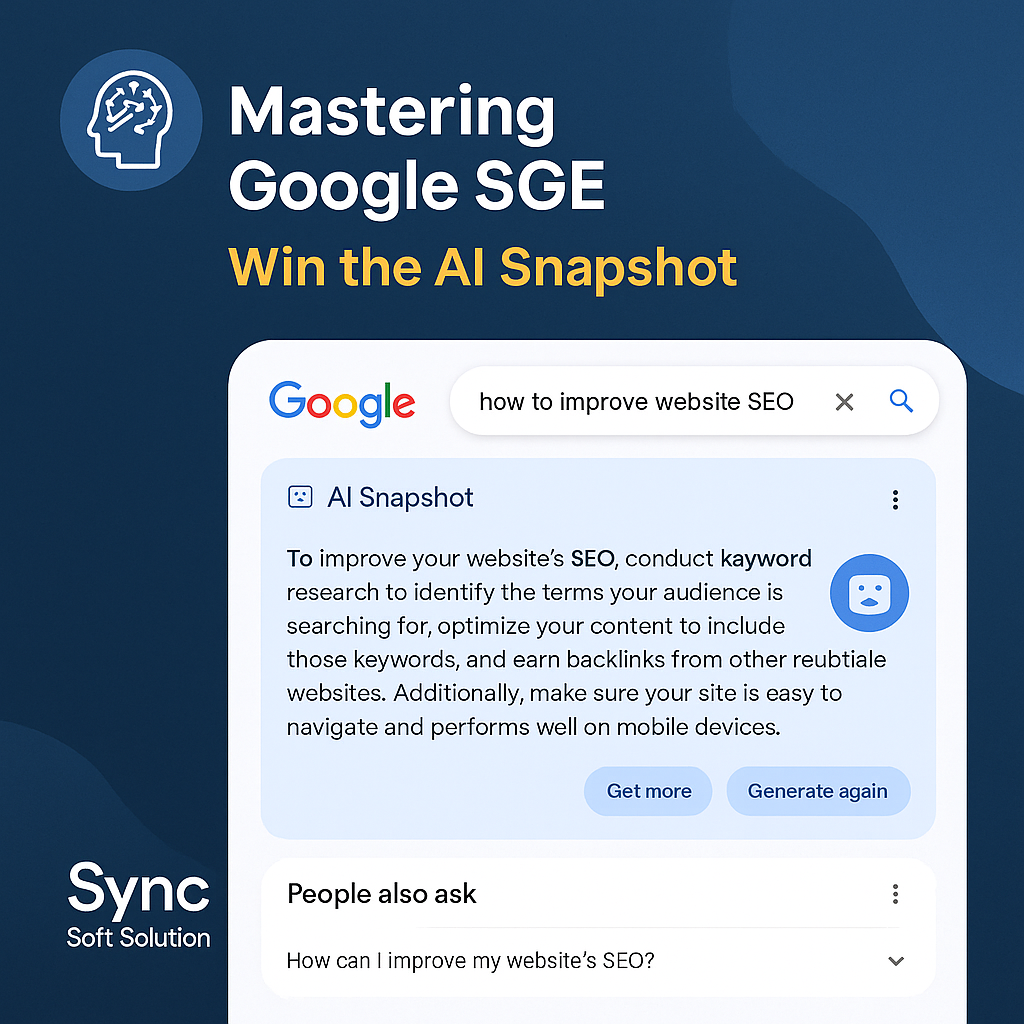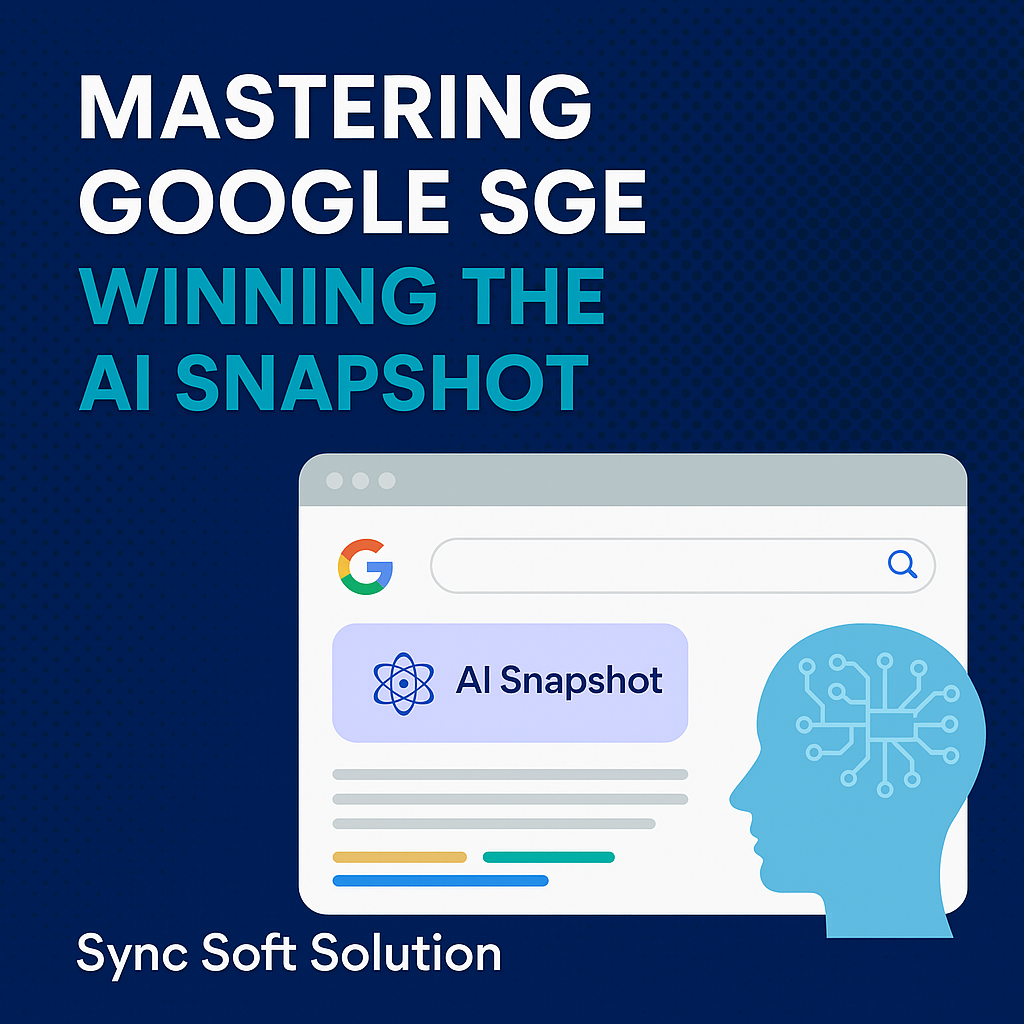Google SGE Search (Generative Experience) rewrites page one by injecting AI‑generated overviews at the top. Brands excluded from these snapshots can see click‑through rates plunge by up to 44 %. This guide unpacks SGE’s ranking mechanics—entity salience, citation eligibility, freshness—and provides a 7‑phase optimisation blueprint tested on 30+ Indian SMB and enterprise projects.


. Anatomy of an SGE Snapshot
An SGE panel contains:
- Boldfaced answer summary (generated)
- Bullet corroborations with coloured backgrounds
- Carousel of source links (3–5 URLs)
- Follow‑up suggestion chips
To appear, your page must first satisfy Google’s quality & diversity filter, then outrank peers on entity‑richness and information gain. The selection is dynamic; each refresh can reshuffle source ordering.
2. SGE Ranking Factors Deep Dive
2.1 Entity Salience Score
Google’s Gemini LLM evaluates how prominently and accurately entities are discussed. Use TopicRank reports to benchmark your salience against competitors. Insert missing entities in natural language, not lists.
2.2 Citation Eligibility Checklist
- HTML load ≤ 150 KB uncompressed
- Author box with
author.url - No aggressive interstitials or paywalls
- Headline without special characters (&, “:”, emojis)
2.3 Freshness Signals
SGE favours pages updated within 90 days. Automate timestamp refresh when new facts or stats are added. Use RSS <pubDate> and IndexNow.
3. Content Engineering Playbook
- Answer First: Summarise query intent in ≤ 50 words.
- Context Build: 200 words elaborating methodology.
- Data Table: Original stats; cite government or academic sources.
- Actionable Takeaway: Bullet list with verbs.
- FAQ Accordion: 3–5 questions; include schema.
Each block is wrapped in semantic HTML and enhanced with data‑ai="snippet" attributes for experimental crawlers.
4. Advanced Schema & Micro‑Markup
Implement FAQPage, HowTo, Speakable, and experiment with Google’s new aiEntity beta extension for clarity. Link author profile to official knowledge graph entry via sameAs pointing to Wikipedia or Crunchbase.
5. Technical Optimisation
- Serve structured data inlined (not separate script) for first paint parsing.
- Implement server‑side rendering (SSR) for React components to prevent hydration delay.
- Compress HTML with Brotli; aim <35 KB gzipped.
6. Monitoring, Testing & Iteration
Use SGE Insights in Search Console → Labs. Track:
- Impressions in AI snapshot
- Clicks to site
- SERP positions versus snapshot inclusion
Complement with SEOTesting’s “SGE monitoring” beta.
7. Case Study: Logistics Client
Global India Express lacked snapshot presence for “courier charges from Delhi to USA.” After applying entity mapping and schema upgrades, impressions in AI Overview grew from 0 to 4,100/wk and organic leads rose 27 % MoM.
8. Action Checklist & Timelines
| Week | Tasks |
| 1 | Baseline audit, salience gap analysis |
| 2–4 | Content block rewrites, schema deployment |
| 5–6 | IndexNow pings, RSS refresh, log monitoring |
| 7–8 | Digital PR for authority backlinks |
Google SGE visibility
SGE visibility is the new rich‑snippet arms race. By mastering entity optimisation, technical hygiene and authoritative storytelling, you can secure prime real estate in AI snapshots and insulate your traffic from zero‑click erosion. Need hands‑on help? Sync Soft Solution’s SGE task force is a call away.
